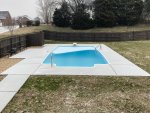- Nov 7, 2018
- 1,049
- Pool Size
- 14000
- Surface
- Plaster
- Chlorine
- Salt Water Generator
- SWG Type
- CircuPool RJ-60 Plus
Also, in regards to the water temp being below 32, I came across this post from Chem Geek (another fantastic poster here who really knows what he is talking about):
And with this info, I *think* I would be OK to just let it ride and let the pump keep on running since the water is running pretty quick through the piping.
I think what they mean is if it's a hard freeze that is VERY cold and where the pool water is already very close to freezing, then even circulating the water won't prevent it freezing somewhere in the pipe and that when this happens and a blockage occurs the pump could be damaged. However, in practice this doesn't happen as I describe below.
Freezing in still water occurs because water density is greatest at 4ºC so when the water gets that cold it sinks to the bottom and colder (less dense) water stays on top. So the surface water can get colder than the deeper water and therefore freezes starting from the top. With moving water, the entire body of water needs to get to freezing (0ºC) in order to freeze and that's a lot more heat to remove from such a larger body of water.
However, if the water in the pool is close to freezing and the pipe is not insulated and loses heat faster than the moving water replenishes that heat, then the water can freeze. This would occur first on the inside surface of the pipe near the inlet into the pool and grow in from there. Given usual rather fast water flow rates through pipes and most especially if the pool water was not near freezing in temperature, it would take an extraordinarily low temperature to cause freezing of moving water in the pipe. If you had a 50 foot pipe run with 2" pipe and even a slow 20 GPM, then the water velocity in the pipe would be just under 2 feet per second so the water would have to drop from it's incoming temperature from the pool down to 0ºC and then lose additional heat to freeze in just 25 seconds.
The enthalpy of fusion for water is 143.6 BTU/lb. and in the example above one pound of water which is 27.7 cubic inches would be in 2" pipe a length of 8.25". So the heat loss through the pipe would have to be 17.4 BTU per inch length of pipe and I'll do calculations assuming a 1" long section of water moving through the pipe. Remember also that water right at the pipe's surface is actually not flowing but I'll ignore this thin layer effect. The thermal conductivity of PVC is 0.19 W/(m•K) which with pipe inner diameter of 2.067" and circumference of 6.49" the area of one inch of pipe is 6.49 sq.in. and the pipe wall thickness is 0.154" minimum. So this is 0.19 * 6.49 / 0.154 = 8 W/K which is 0.0042 BTU/sec/ºF (this is per inch of pipe length and we are considering a 1" long section of water moving through the pipe) so over 25 seconds (time for water to flow through 50 feet of pipe) this is 0.11 BTU/ºF so a minimum of 17.4/0.11 = 165ºF temperature difference (i.e. below freezing so -133ºF).
It is far more likely is to see freezing begin at the pool water's surface.
Note that if I were to repeat the calculation for copper pipe that was not insulated and where the water flow was only 1 GPM then Type M copper pipe that I'll assume outside is 3/4" is 0.032" thick and thermal conductivity is 401 W/(m•K) so over the same 50 feet pipe run, 0.811" inner diameter, circumference of 2.55" we have 401 * 2.55 / 0.032 = 32000 W/K which is 17 BTU/sec/ºF. 1 GPM in this pipe is 6.21 feet per second so 50/6.21 = 8 seconds. So we have 17.4 / (17 * 8) = 0.13ºF which is why you have to insulate copper piping significantly to prevent freezing even if you were to run the water, but note that actual freezing never occurs this quickly since I ignored heat movement in the water to form ice and time for ice to form (i.e. an amount of heat that needs to be removed to form ice does not mean it is actually removed that quickly). Basically, as ice forms it limits the heat transfer as ice thermal conductivity is 2.18 W/(m•K) so if I use that then we have (401/2.18) * 0.13 = 24ºF but that's just for 0.032" thick ice so for 0.32" thick it's 240ºF. Or put another way, for a 20ºF below freezing it would take minutes (in practice it's hours). It would seem that running water even through uninsulated copper pipes would prevent them from freezing.
Polyurethane foam has thermal conductivity of 0.03 W/(m•K) and is typically 3/8" thick so is (401 / 0.03) * (3/8) / 0.032 = 150,000 times more insulating than the bare copper pipe so at 1 GPM this is 20,000ºF so insulated pipe with even very slow moving water simply won't freeze. (Someone should double check my calculations since there's a lot going on and I may have made a mistake, but the order of magnitude point is valid)
And with this info, I *think* I would be OK to just let it ride and let the pump keep on running since the water is running pretty quick through the piping.
Last edited:






